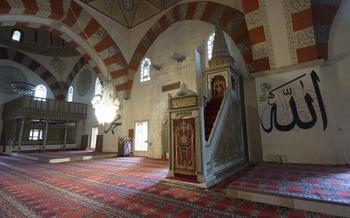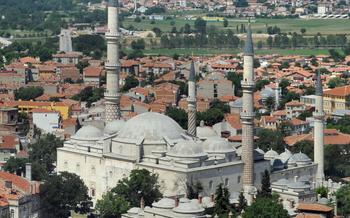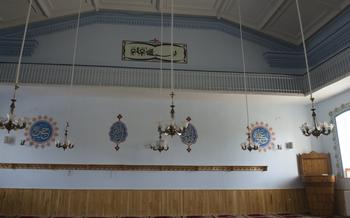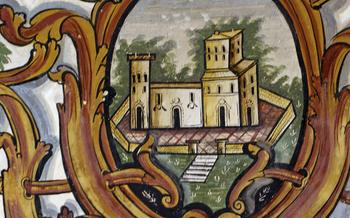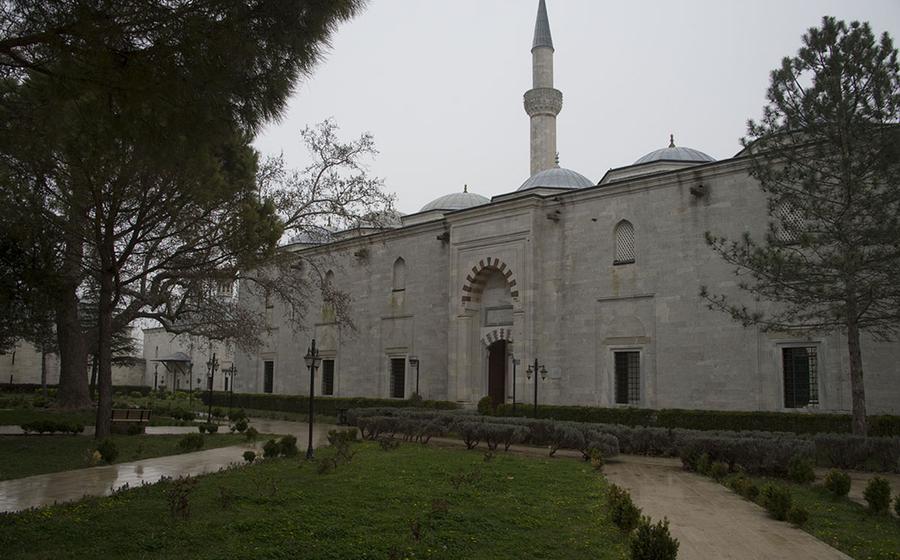
Sultan II. Bayezid Mosque
- History of the Sultan II. Bayezid Mosque
- Location and Accessibility
- Architectural Grandeur
- Religious Significance
- Cultural and Social Hub
- Historical Restoration
- Visiting Hours and Etiquette
- Exploring the Mosque's Interiors
- Surrounding Gardens and Courtyard
- Experiencing the Call to Prayer
- Photography and Videography Guidelines:
- Local Customs and Traditions
- Tips for a Meaningful Visit
- Educational Programs and Workshops
History of the Sultan II. Bayezid Mosque
The Sultan II. Bayezid Mosque, an architectural masterpiece in Edirne, Turkey, stands as a testament to the reign of Sultan Bayezid II, one of the most prominent rulers of the Ottoman Empire. Constructed between 1484 and 1488, the mosque holds immense historical significance as a symbol of the sultan's architectural patronage and piety.
During Sultan Bayezid II's reign, the Ottoman Empire witnessed a remarkable period of prosperity and cultural advancement. As a patron of the arts, Sultan Bayezid II commissioned the construction of numerous mosques, bridges, and madrasas throughout his empire. The Sultan II. Bayezid Mosque, with its grandeur and intricate design, stands as a testament to the sultan's commitment to leaving a lasting legacy.
The mosque's architectural style reflects a blend of traditional Islamic and Ottoman elements. Its striking features include a spacious courtyard, a single massive dome, and four slender minarets. The mosque's interior is adorned with exquisite tilework, intricate calligraphy, and decorative elements, showcasing the high level of craftsmanship during the Ottoman period.
Throughout its history, the Sultan II. Bayezid Mosque has witnessed significant events. It served as a place of worship for the Ottoman sultans and their entourage during their visits to Edirne. The mosque also played a crucial role in religious ceremonies and festivals, becoming a focal point for the Muslim community in the region.
Location and Accessibility
The Sultan II. Bayezid Mosque is situated in the heart of Edirne, a city in northwestern Turkey. Its convenient location makes it easily accessible for both local residents and tourists. To reach the mosque, visitors can utilize various transportation options. Public buses and trams provide frequent service, connecting the mosque to different parts of the city. Alternatively, taxis and rental cars are readily available for those seeking a more personalized experience.
Once you arrive in the vicinity of the mosque, you will be greeted by a lively atmosphere. The mosque stands proudly amidst a bustling cityscape, surrounded by traditional Turkish houses, shops, and cafes. The surrounding area is steeped in history and culture, with notable landmarks such as the Edirne Palace and the Selimiye Mosque within walking distance. Exploring the Sultan II. Bayezid Mosque offers a unique opportunity to immerse yourself in the rich tapestry of Edirne's heritage.
Architectural Grandeur
The Sultan II. Bayezid Mosque stands as a testament to the architectural prowess of the Ottoman Empire. Its exterior design is characterized by a harmonious blend of Islamic and Byzantine influences, featuring intricate stone carvings, decorative tiles, and elegant arches. The mosque's imposing dome, a symbol of Ottoman grandeur, dominates the skyline and serves as a beacon for the faithful. Four slender minarets, each adorned with intricate balconies, gracefully rise from the corners of the mosque, providing a striking visual contrast to the dome's rounded form. Within the mosque's walls, visitors are greeted by a spacious courtyard, offering a tranquil sanctuary for prayer and contemplation. The courtyard is surrounded by an arcade of pointed arches, supported by slender columns, creating a sense of lightness and elegance.
Religious Significance
The Sultan II. Bayezid Mosque holds immense religious significance for the Muslim community in Edirne and beyond. It serves as a central place of worship, where Muslims gather for daily prayers, including the five mandatory daily prayers (salat). The mosque also hosts special ceremonies and religious festivals, such as the annual Mevlid Kandili, which commemorates the birth of Prophet Muhammad. During these events, the mosque's spacious prayer hall reverberates with prayers, recitations, and spiritual reflections, creating a profound and moving ambiance. The mosque's role extends beyond religious rituals; it serves as a hub for spiritual guidance and education, where scholars and religious leaders impart knowledge about Islam and its teachings, fostering a deep connection between the mosque and the local community.
Cultural and Social Hub
Beyond its religious significance, the Sultan II. Bayezid Mosque serves as a vital cultural and social hub for the community. The mosque's spacious courtyard provides a welcoming gathering space for locals to socialize, exchange ideas, and strengthen their bonds. This vibrant communal atmosphere is further enhanced by various educational and social activities organized at the mosque. These initiatives range from religious classes and workshops to cultural events and community gatherings.
The mosque also plays a crucial role in preserving and promoting Turkish cultural traditions. Regular events showcasing traditional Turkish arts, music, and crafts are held within the mosque's premises. These events not only entertain and educate but also foster a sense of cultural pride among the community members. The mosque's commitment to preserving and celebrating Turkish heritage makes it a living embodiment of the country's rich cultural tapestry.
Historical Restoration
The Sultan II. Bayezid Mosque has undergone several renovation and restoration efforts throughout its history. In the 19th century, the mosque underwent significant repairs and enhancements, including the reinforcement of its foundations and the restoration of its interior decorations. During the 20th century, further restoration work was carried out, focusing on preserving the mosque's original architectural features and repairing any damage caused by natural disasters or the passage of time.
One of the challenges faced during the restoration process was the need to balance the preservation of the mosque's historical integrity with the incorporation of modern amenities and safety features. The restoration team worked diligently to ensure that any modifications made to the mosque were in keeping with its original design and did not detract from its historical significance.
Preserving the Sultan II. Bayezid Mosque's historical integrity is of utmost importance, as it serves as a valuable testament to Ottoman architecture and the reign of Sultan Bayezid II. By maintaining the mosque's original features and preserving its historical context, future generations can continue to appreciate and learn from this architectural masterpiece.
Visiting Hours and Etiquette
The Sultan II. Bayezid Mosque welcomes visitors during specific hours to ensure the sanctity of religious practices. To fully immerse yourself in the spiritual ambiance, it's essential to adhere to appropriate visiting etiquette.
Visiting Hours:
- The mosque is typically open to visitors daily, except during prayer times.
- Prayer times vary throughout the day, so it's advisable to check local sources or the mosque's official website for precise timings.
- During non-prayer hours, visitors are welcome to explore the mosque's interior and exterior.
Dress Code and Behavior:
- As a place of worship, modest attire is expected when visiting the mosque.
- Both men and women should dress respectfully, covering their shoulders and knees.
- Avoid wearing revealing or tight-fitting clothing.
- Maintaining a respectful demeanor is essential.
- Be mindful of noise levels, as loud conversations or boisterous behavior may disrupt worshippers.
- Photography and videography are permitted in designated areas, but using flash photography or tripods is generally discouraged.
By following these guidelines, you can ensure a respectful and meaningful visit to the Sultan II. Bayezid Mosque, appreciating its architectural grandeur and spiritual significance.
Exploring the Mosque's Interiors
Stepping inside the Sultan II. Bayezid Mosque, visitors are captivated by the intricate details and harmonious blend of architectural elements. The prayer hall, the heart of the mosque, is a vast and awe-inspiring space, adorned with intricate tilework and calligraphy that create a mesmerizing visual symphony. The mihrab, the niche indicating the direction of Mecca, is a masterpiece of craftsmanship, featuring intricate carvings and colorful tiles. The minbar, the elevated platform from where the imam delivers sermons, is adorned with delicate carvings and inlaid with mother-of-pearl, showcasing the exceptional artistry of the Ottoman era.
The mosque's collection of historical artifacts and manuscripts adds to its cultural and religious significance. These artifacts, carefully preserved and displayed, offer a glimpse into the mosque's rich history and the vibrant Islamic traditions that have shaped the region. Visitors can admire rare Qur'anic manuscripts, beautifully illuminated with intricate calligraphy, as well as historical documents that shed light on the mosque's construction and evolution over the centuries.
Surrounding Gardens and Courtyard
The courtyard of the Sultan II. Bayezid Mosque is an oasis of tranquility amidst the bustling city. Ornamental gardens with vibrant flowers, lush green lawns, and fragrant trees create a serene atmosphere that invites visitors to relax and contemplate. The courtyard is adorned with intricate tilework, refreshing fountains, and inviting seating areas, making it an ideal spot to unwind and soak in the mosque's spiritual ambiance.
The courtyard is not just a place for relaxation but also holds significant religious importance. It serves as a gathering space for the community, where worshippers can socialize, exchange greetings, and foster a sense of togetherness. The courtyard is also used for religious ceremonies and events, such as the Mevlid, the Prophet Muhammad's birthday celebration, which attracts large crowds of devout Muslims.
Experiencing the Call to Prayer
The call to prayer, known as the adhan, is a captivating and melodic chant that resonates through the streets of Edirne five times a day, echoing from the minarets of the Sultan II. Bayezid Mosque. Performed by the muezzin, the call serves as an invitation for the faithful to gather for prayer. As the melodious voice reverberates through the air, it creates a spiritual ambiance that envelops the entire city.
The adhan is not merely a call to prayer; it is an integral part of Islamic tradition and culture. It marks the beginning of each of the five daily prayers, reminding Muslims to pause and connect with their faith. The muezzin's voice, often amplified through loudspeakers, carries a unique charm that transcends religious boundaries, captivating even non-Muslims with its enchanting melodies.
For visitors to the Sultan II. Bayezid Mosque, experiencing the call to prayer is a profound and awe-inspiring moment. It offers a glimpse into the deep spiritual traditions of Islam and the vibrant religious life of Edirne. Whether you are a Muslim or not, witnessing the adhan is a truly special and unforgettable experience.
Photography and Videography Guidelines:
When visiting the Sultan II. Bayezid Mosque, it is essential to be mindful of the sacred nature of the space and respect the privacy of worshippers. Photography and videography are generally permitted within the mosque, but there are certain guidelines that visitors must follow.
Designated areas within the mosque are suitable for taking photos and videos. These areas typically include the courtyard, exterior facades, and certain sections of the interior that are not being used for prayer. Visitors should avoid taking photos or videos of worshippers without their consent and refrain from using flash photography or tripods, as these can be disruptive.
It is crucial to maintain silence and avoid any actions that may disturb the serenity of the mosque. Visitors should be respectful of the religious customs and traditions associated with the mosque and refrain from engaging in inappropriate behavior or conversations that may cause offense.
By adhering to these guidelines, visitors can ensure that their experience at the Sultan II. Bayezid Mosque is both enjoyable and respectful of the mosque's sacred significance.
Local Customs and Traditions
When visiting the Sultan II. Bayezid Mosque, it is important to be respectful of the local customs and traditions. Dress modestly and avoid wearing revealing clothing. Shoes must be removed before entering the prayer hall, and a headscarf is required for women. Silence is expected inside the mosque, and visitors should avoid talking or making noise that may disturb worshippers.
Taking the time to engage with the local community around the mosque can be a rewarding experience. Turks are generally friendly and welcoming, and they are often happy to share their customs and traditions with visitors. Be sure to greet people with a warm "Merhaba" (hello) and don't be afraid to ask questions. You may even be invited to join in on a traditional Turkish coffee or tea ceremony.
Remember that the mosque is an active place of worship, and it is important to be respectful of the religious sentiments of the worshippers. Avoid pointing your feet towards the qibla (the direction of prayer) and be mindful of not blocking the passage of worshippers during prayer times. By following these simple guidelines, you can help ensure that your visit to the Sultan II. Bayezid Mosque is a positive and enriching experience.
Tips for a Meaningful Visit
To make the most of your visit to the Sultan II. Bayezid Mosque, consider these tips:
-
Visit during the early morning or late afternoon: These times tend to be quieter, allowing you to explore the mosque at your own pace and capture beautiful photos without crowds.
-
Combine your visit with other nearby attractions: The mosque is situated in the historic center of Edirne, surrounded by other notable landmarks such as the Edirne Palace and the Selimiye Mosque. Plan a day of exploration to discover the rich heritage of this charming city.
-
Consider hiring a local guide: For a deeper understanding of the mosque's history, architecture, and significance, consider hiring a local guide. They can provide insights into the mosque's construction, unique features, and its role in the local community.
Educational Programs and Workshops
The Sultan II. Bayezid Mosque offers a range of educational programs and workshops that delve into the mosque's rich history, Islamic architecture, and cultural significance. These programs are designed to provide visitors with a deeper understanding and appreciation of the mosque's unique features and its role in the local community.
One popular program is the "History of Islamic Architecture" workshop, which explores the evolution of Islamic architectural styles and design elements, using the mosque as a prime example. Participants learn about the symbolism and functionality of various architectural features, such as domes, minarets, and courtyards.
Another popular offering is the "Calligraphy and Tilework" workshop, where participants can try their hand at creating beautiful Islamic calligraphy and decorative tile patterns, inspired by the intricate designs found within the mosque. These workshops provide a hands-on experience and a deeper appreciation for the artistry and craftsmanship that went into the mosque's construction.
For those interested in learning more about the mosque's spiritual significance, the "Understanding Islam" workshop offers insights into Islamic beliefs, practices, and the role of mosques in Muslim communities. Participants engage in discussions, readings, and Q&A sessions, gaining a better understanding of the religion and its cultural expressions.
These educational programs and workshops are an excellent way to enhance your visit to the Sultan II. Bayezid Mosque. They provide a unique opportunity to learn from experts, engage with the local community, and gain a deeper appreciation for the mosque's historical, architectural, and cultural significance.

